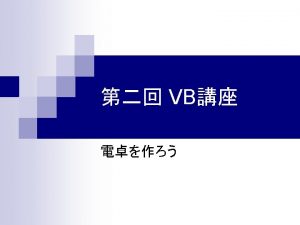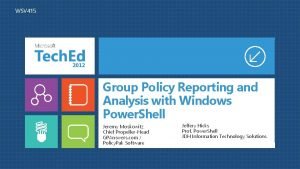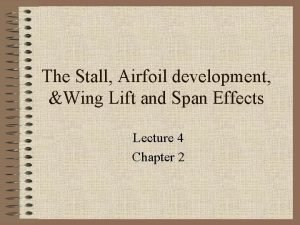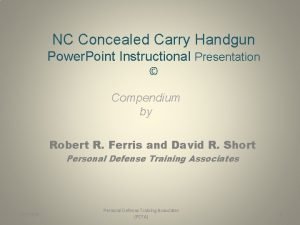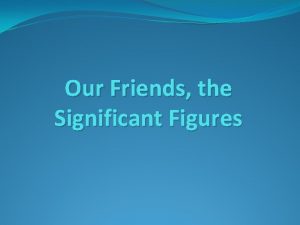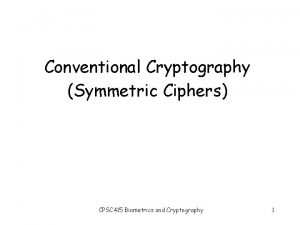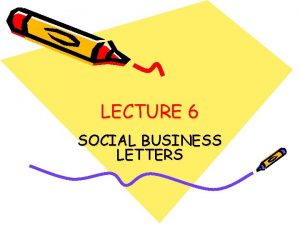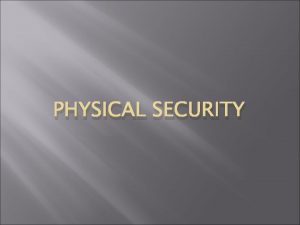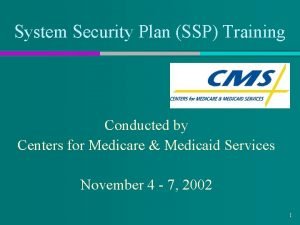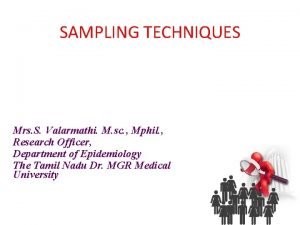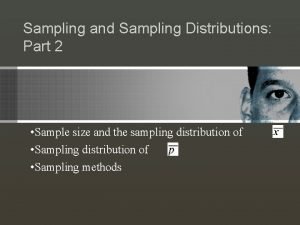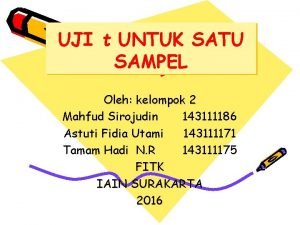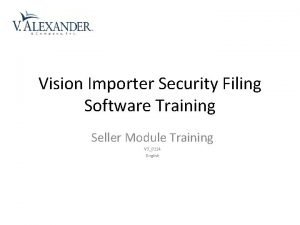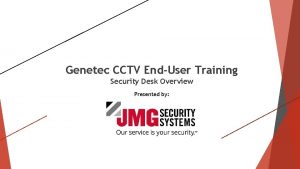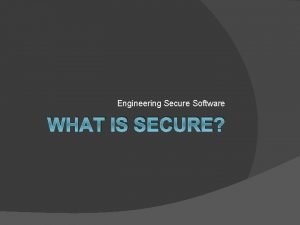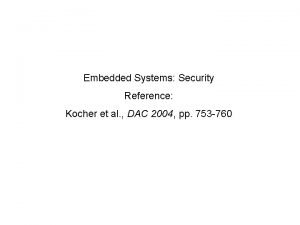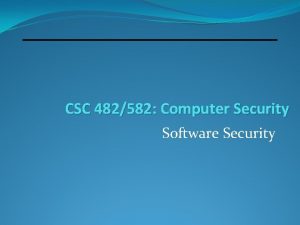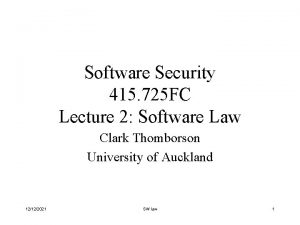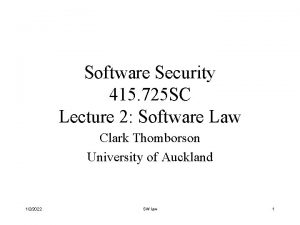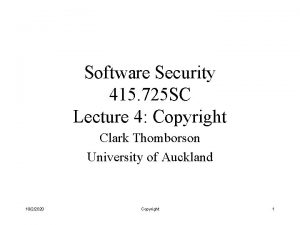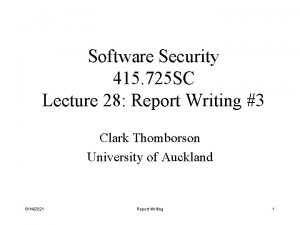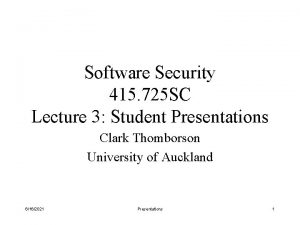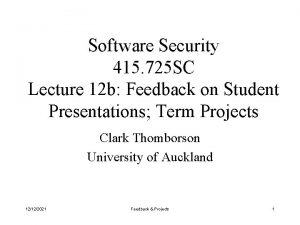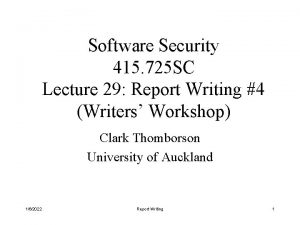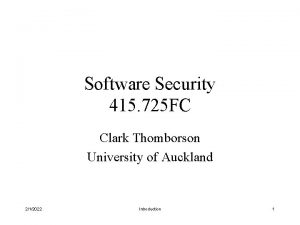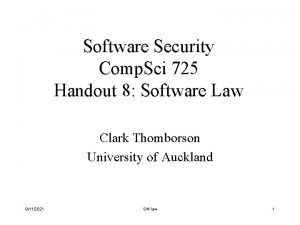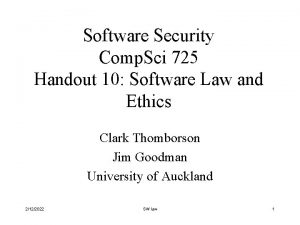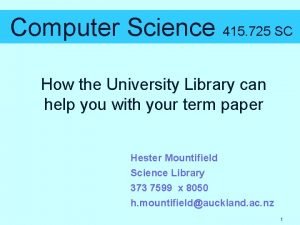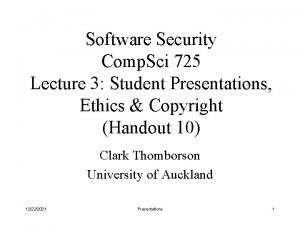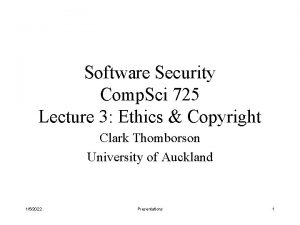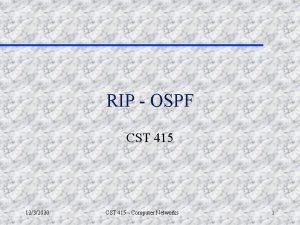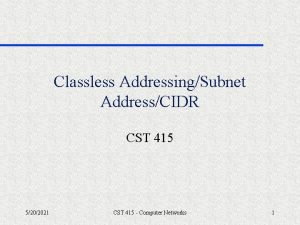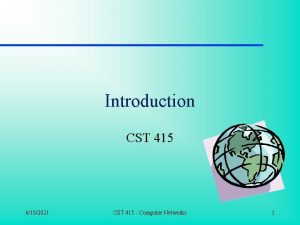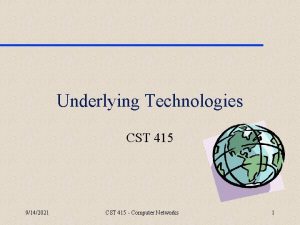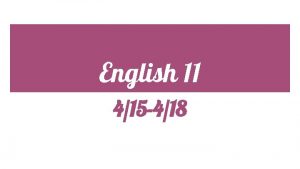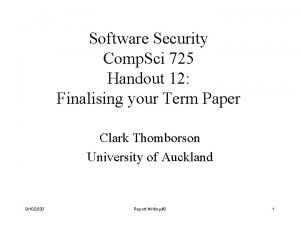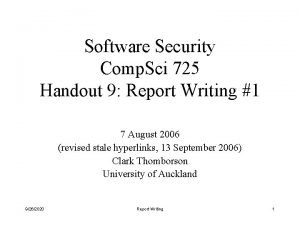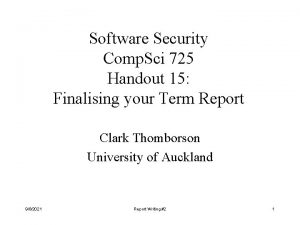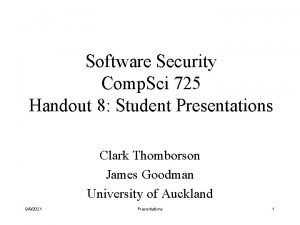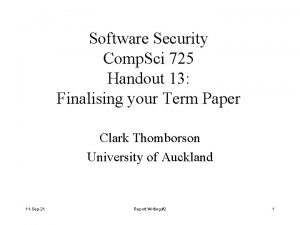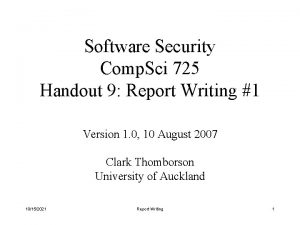Software Security 415 725 SC Lecture 31 Sample










![Student #3’s Answer to Q 3 1. encrypt HA with securet [sic] key of Student #3’s Answer to Q 3 1. encrypt HA with securet [sic] key of](https://slidetodoc.com/presentation_image_h2/4d48589ef577e3ebf139fd91e8b82c1c/image-11.jpg)































- Slides: 42

Software Security 415. 725 SC Lecture 31: Sample Final Exam Clark Thomborson University of Auckland 1/2/2022 Sample Exam Questions 1

Q 1. Legal, Ethical and Conceptual Frameworks • Consider the three goals of security, defined in Pfleeger’s book: confidentiality, integrity, availability. Also consider his classification of assets: hardware, software, data. • Which of Pfleeger’s security goals, for which of Pfleeger’s asset classes, are protected by the following clause of the Computer Science Department’s Computer Systems Regulations of 17 September 1999: “No person shall … use a login name other than the one(s) assigned to that person by the Department or allow any other person to use that person’s login name(s) to access one of the Department’s computer systems without the express permission of the Director of that system. ” • Explain your answer briefly (in approximately 50 words). 1/2/2022 Sample Exam Questions 2

Student 1’s Answer to Q 1 • The users logon (data) (and password) is confidential as it is ONLY for a specified user. It is NOT for anyone else. It also has an integrity aspect where whoever has the logon can change the password portion of it. • Also there are weak links to other aspects of Swe [? ] data integ/confid avail. Whoever shouldn’t accesses the system has access to whatever’s on the system. 1/2/2022 Sample Exam Questions 3

My Evaluation of S 1/Q 1 • This student didn’t realise that the clause covers hardware, as well as data; the student makes a brief reference to “SWe” which might be a nonstandard abbreviation for software. • Confidentiality is correctly noted, however the student didn’t realise that the authorisation aspect of Pfleeger’s “integrity” goal is the primary focus of the quoted clause. • My evaluation: C+. 1/2/2022 Sample Exam Questions 4

Student #2 on Q 1 • This covers confidentiality and integrity. – Confidentiality because the users whose account is being used has a right to privacy in his or her home dir. – Integrity because the account may have access to resources that the “hacker” should not have access to, the hacker may alter data structures in a way s/he shouldn’t. • It covers all the classification of assets as using a given account may give unauthorized access to any of the items, hardware (changing h/w settings), software (running unauthorized s/w) and data (access to data). 1/2/2022 Sample Exam Questions 5

My Evaluation of S 2/Q 1 • This student correctly identifies the goals and asset classes, in an answer that indicates good understanding. • A minor defect in the answer is that it doesn’t consider the context of the quoted clause, leading to a misplaced emphasis on confidentiality. • It is reasonable to suppose that these regulations (and this clause in particular) were designed primarily to insure the integrity of the computer science department’s assets, not to protect the confidentiality of our users – so confidentiality is a secondary goal, not a first-equal goal to integrity as is suggested in this student’s response. • My evaluation: A-. 1/2/2022 Sample Exam Questions 6

Q 2: Cryptographic Authentication, e-Commerce, and Secure Communication • The first step in Aucsmith’s “Identity Verification Protocol” is F 0 = ( HA == K 1 A[ K-1 A[ HA ] ] ). In this formula, the variables have the following definitions: – HA is a hash value computed over the code of module A, – K-1 A is a private key of the Integrity Verification Kernel (IVK) embedded in module A, – K 1 A is a public key of the IVK embedded in module A, – F 0 is a flag value indicating the success or failure of an operation, and – K-1 A[ HA ] is the signature of module A under A’s private key. This value was computed at compile-time and is stored in some secret fashion within module A. • Which of the following phrases best describes this step in Aucsmith’s IVP? a) A verifies self; b) A challenges E; c) F verifies self; d) E responds to A; e) E verifies A; f) A checks response. 1/2/2022 Sample Exam Questions 7

Student #3’s Answer to Q 2 • e • My evaluation would be deferred until I read this student’s answer to the following question. My delay would give this student a second chance to explain their incorrect answer. The student is probably confusing the first step of Aucsmith’s protocol with the fourth step, which is “E verifies signature of A and reports any failure F 2 = ( HA == K-1 E[ K 1 E[ HA ] ] ). ” However I don’t expect students to recall details of a complex protocol, so I would be open to giving partial credit to an incorrect answer if it is accompanied by a plausible explanation. 1/2/2022 Sample Exam Questions 8

Student #4’s Answer to Q 2 • A verifies self. • My evaluation: A. • Note: your final exam script will show a total number of marks possible for each question. I would give equal weight to each of the five sections of this sample exam, and I would give less weight to a multiple-choice question like this one. So if this sample final were a 100 -mark test, question 2 would be a 5 -mark question and question 3 would be a 15 -mark question. 1/2/2022 Sample Exam Questions 9

Q 3. (Continuation of Q 2) • Briefly explain (in approximately 50 words) the individual calculations or function evaluations made during the first step in Aucsmith’s IVP. 1/2/2022 Sample Exam Questions 10
![Student 3s Answer to Q 3 1 encrypt HA with securet sic key of Student #3’s Answer to Q 3 1. encrypt HA with securet [sic] key of](https://slidetodoc.com/presentation_image_h2/4d48589ef577e3ebf139fd91e8b82c1c/image-11.jpg)
Student #3’s Answer to Q 3 1. encrypt HA with securet [sic] key of K-1 A; 2. decrypt the K-1 A[ HA ] with public key of K 1 A; 3. matching the result from previous two steps with HA. If they are matching, set F 0 to true otherwise set to false. Note: the calculation is given in Q 2 as F 0 = ( HA == K 1 A[ K-1 A[ HA ] ] ) 1/2/2022 Sample Exam Questions 11

My Evaluation of S 3/Q 3 • This student has made a major error in their answer, incorrectly including a preprocessing step (of computing the signature of A under A) in their description of the operations that would be taken at verification-time in Aucsmith’s IVP. • The student has made a second major error, by not clearly identifying the (rather time-consuming) computation required to obtain the current value of HA by computing a hash-digest over the current code and static data in module A. 1/2/2022 Sample Exam Questions 12

My Evaluation of S 3/Q 3 (cont. ) • The student has also made a minor error of misspelling the technical phrase “secret key”. • There are several grammatical errors in this answer, however it is quite understandable except for the technical confusion that would arise if I were to translate the misspelled word “securet” into “security”. So these grammatical errors would have no effect on the student’s grade. • My evaluation: D. This student is saved from an “F” grade on this question by their appropriate use of the descriptive terms “encrypt” and “decrypt” in their explanation. 1/2/2022 Sample Exam Questions 13

Student #4’s Answer to Q 3 a) Firstly A computes a hash of its own code as it is currently running. b) K-1 A[ HA ]: this is a stored value. When the module was compiled by the distributer [sic] the hash was calculated and encrypted with A’s private key to give this value. c) K 1 A [ … ]: A decrypts the stored hash value using its public key. This occurs at run-time. It therefore recovers the original hash value that was calculated at compile time. d) HA = K 1 A [ …]: The current hash and compiled hash are compared. e) F 0 = ( … ): If they mismatch the flag is set to failure. 1/2/2022 Sample Exam Questions 14

My Evaluation of S 4/Q 3 • The student shows excellent understanding of the protocol, by describing each step in good detail without making any technical errors. • I would not mark down the misspelled word “distributor” because it is not a technical error. • My evaluation: A. • I am pleased to report that most students did very well on this question in the sample exam. 1/2/2022 Sample Exam Questions 15

Q 4. Protection of Hosts • Briefly describe one assumption about computer system security, which is valid for non-mobile systems, but is violated for mobile code systems. 1/2/2022 Sample Exam Questions 16

Student #5’s Answer to Q 4 • In a non-mobile system the host is trusted. This assumption cannot be made by mobile code in a mobile code system. 1/2/2022 Sample Exam Questions 17

My Evaluation of S 5/Q 4 • The student identifies an assumption (“the host is trusted”) that was not discussed in the article on mobile code security you read for this class, so I would examine the student’s answer on its own merits to decide if it shows reasonable understanding of any other article or lecture material in this class. • Other class readings have discussed reasons why hosts should NOT be trusted unconditionally in all respects, even in non-mobile systems. 1/2/2022 Sample Exam Questions 18

My Evaluation of S 5/Q 4 (cont. ) • S 5’s assertion about security in non-mobile systems shows very little understanding of the course material, and is unaccompanied by any reasonable definition of what the student means by a “trusted” host. • Furthermore, this student does not explain why adding mobility to code should destroy all our trust in a host (to the point that we cannot even make this assumption). • My evaluation: D-. The student is saved from an “F” by their naming of an important issue in computer security, even though it is far from clear that they understand this issue. 1/2/2022 Sample Exam Questions 19

Student #6’s Answer to Q 4 • The user is the principle and all programes run by the user do only what the user wants. In nonmobile code systems code can run with the rights of the user and be executed safly. With mobile code systems the user may not know what a programme does (or that it is running at all) hence there must be a differnt principle (programmer / distributer / signing authority). 1/2/2022 Sample Exam Questions 20

My Evaluation of S 6/Q 4 • This student shows an excellent understanding of the article by Chess on “Mobile Security”. • One of the main themes of the article was explaining why “Identifying Programs with Persons” is a problematic assumption in mobile code systems. This assumption is generally true in non-mobile systems though (with a few exceptions, such as programs that run as “setuid root” under Unix). • Within the space available, and in s/his own words, this student does an excellent job of summarising Chess’ discussion. 1/2/2022 Sample Exam Questions 21

My Evaluation of S 6/Q 4 (cont. ) • This student barely misses an A+ on this answer, by misspelling the technical word “principal” as “principle”. Confusing a “principle” with a “principal” is a common error in technical writing, so I wouldn’t mark down harshly for this. • Also “programmes” may be spelled as “programs” but never as “programes”. • I would not mark down for the misspelling of “safely” and “different”, even though both were missing an “e”, or for misspelling “distributor” because these words do not have sharp technical meanings and the student’s meaning was crystal clear. 1/2/2022 Sample Exam Questions 22

“Principal” and “Principle” • “A principal in a security system” is an actor. • “A security principle” is a rule or guideline. • A principal has the right to act (within limits) in a security system. – A principal (if it is a human female) may act in accordance with her ethical principles. – A principal (if it is a software object) may act in accordance with its design principles. • An operating system might be designed with the following security principle in mind: – The security rights of a principal must be checked before it is allowed to act. 1/2/2022 Sample Exam Questions 23

Another “Principal” Word • In ungrammatical sentences, the adjective “principal” (meaning primary, main, chief) could be confused with the nouns “principal” and “principle” discussed on the previous slide. 1/2/2022 Sample Exam Questions 24

Copy Detection 5. Consider the following images. Sketch the image that would result Figure 1. if the Checkerboard (Figure 1) is Checkerboard. watermarked with the Copyright Notice (Figure 2), using the leastsignificant bit embedding described in the paper by Johnson and Jojodia. Copyright 2000 C Thomborson 1. Figure 2. Copyright Notice. 1/2/2022 Sample Exam Questions 25

Student #7’s Answer to Q 5 • Problem of depth of the cover image – assuming 256 level grey scale (8 bit). – 1 bit isn’t much to encrypt in. [The student’s sketch shows the Copyright Notice overlaid on the Checkerboard. ] • -- except writing would distort the white. It would be really faint grey (slightly darker). Also the black checks would be slightly lighter as they have LSB set to 1, except where writing is – it would be full black. 1/2/2022 Sample Exam Questions 26

My Evaluation of S 7/Q 5 • A+. This student shows an excellent understanding of the LSB embedding process. • In addition, Student 7 correctly points out, and resolves appropriately, an ambiguity in my question. – The article discusses 8 -bit and 24 -bit images in detail, and mentions 4 -bit images in passing. – As the student points out, 1 -bit images are also possible, and my black/white image could indeed be encoded in 1 bit/pixel. • The student’s picture and explanation are accurate for 8 -bit images. 1/2/2022 Sample Exam Questions 27

Student #8’s Answer to Q 5 • The sketched image depends on how many leastsignificant bits are used and how many bytes are used to present colors. • In this case for example, the figure 2: Copyright Notice consists of “Copyright 2000 Clark Thomborson” which is black and white which only need one bit to present its color or gray scale. • It nearly apply not changes to Figure 1 so the image will be the same as “Figure 1. Checkboard” as before. 1/2/2022 Sample Exam Questions 28

My Evaluation of S 8/Q 5 • Student 8 has correctly pointed out an ambiguity in my question, however it is not at all clear what assumption they are making to resolve the ambiguity: have they assumed 1 -bit or 8 -bit pixels in the cover image? • The student’s last sentence is also ambiguous. – “[N]early apply not changes” implies that a small change has been made. – “[B]e the same as” means that no change has been made. – Perhaps the student is trying to say that the image “would appear the same to a human observer. ” – In their next answer, student #8 writes “the watermark is [undetectable] to our eyes” so I will use this statement to resolve the ambiguity of their answer to this question. • The student’s grammar is weak, but their meaning is clear except as noted above. • Grade: A 1/2/2022 Sample Exam Questions 29

Question 6 • Characterise the watermarked image you constructed in your answer to the previous question, in terms of its fidelity, robustness, and security. Use the definitions of Matheson et al. for these terms. 1/2/2022 Sample Exam Questions 30

Student #7’s Answer to Q 6 • Fidelity – is somewhat noticeable if you can see this kind of thing, being greyscale would not help. Probably most people would not see it, so the image would look fairly normal. • Robustness – something like JPEG would probably delete the LSB to improve compression. Would not be difficult to remove if you knew about it – simply replace LSB with noise or change all colours to be black or white. 1/2/2022 Sample Exam Questions 31

My Evaluation of S 7/Q 6 • B+. The student has demonstrated an excellent memory and understanding of Matheson’s definition of “fidelity”. • The student seems to understand the distinction between “robustness” and “security”, even though the latter term does not appear in their answer. • This student would have received an A evaluation on this question, if the last sentence in their answer were clearly intended as a discussion of the “security” of this watermark. 1/2/2022 Sample Exam Questions 32

Student #8’s Answer to Q 6 • In this example. Fidelity is not guaranteed in the case of only a few color or gray scale, however for over 250 colors or gray scale, we can think it maintains fidelity because the watermark is undectable to our eyes. • Robustness: obviously it is not robustness. The weakness results from the defects of the leastsignificant embedding algorithm itself. • Security: it is secure because it is hard to detect. It is no secure once it has been detected and it is ease to remove. 1/2/2022 Sample Exam Questions 33

My Evaluation of S 8/Q 6 • A-. This student shows an excellent critical and appreciative understanding of the LSB embedding process, by applying Matheson’s analytic framework accurately and fully. • The answer is weak on “robustness”, where the unhelpful word “obviously” and the vague “defects of the … algorithm itself” convey very little explanatory information. • However the remainder of the answer is clear, direct and concise, even though it is somewhat ungrammatical. 1/2/2022 Sample Exam Questions 34

Copy Prevention 7. Consider the following assertion: “Any secrets carried in Java bytecode written today, could be easily attacked tomorrow by a reverse engineer who has access to the decompiler described by Proebsting and Watterson. ” Make a brief argument for, or against, this assertion. 1/2/2022 Sample Exam Questions 35

Student #9’s Answer to Q 7 • We can view this assertion from two sides: – it’s true: Because of the similarity between java bytecode and sourcefile, people make use of utility like javap to get the class file, and people have really developed many tools to reverse this classfile to sourcefile, such as tools in www. sourceagain. com or karokata. – it’s not so true: In java 2, we’ve very rich security mechanism in security package, where we can sign the sourcefile to protect its copyright. We also have obfuscator to change the datastructure, variable, abstraction of java files. Actually, we can transplant every advanced security technology to java to protect the source files. • Finally: there’s no absolute secure system in the world, java is the most secure language among the existing ones. If there’s no important breakthrough in java security architecture, java can only patch the holes after the holes are found out. 1/2/2022 Sample Exam Questions 36

My Evaluation of S 9/Q 7 • B. This student has demonstrated a very good understanding of the reverse-compilation process. • They have correctly identified obfuscation as the main method of defense against decompilation. • However, this student has incorrectly characterised the java 2 code-signature techniques as providing a defense against a reverse engineer. – Signatures are a mechanism to demonstrate integrity and authenticity to the end-user. – A reverse engineer could easily remove or ignore signatures. – Indeed, a signature may assist a reverse engineer by assuring the integrity and authenticity of the code being attacked! 1/2/2022 Sample Exam Questions 37

Student 10’s Answer to Q 7 • The reverse engineering is developed very fast now. Sometimes we really see a lot of cases that the reverse engineer use the decompiler attack the java byte code but the security technical method is also developing such as java obfuscation watermark fingerprint etc. • Java bytecode is protected not only by the software control but also by the cyberlaw, by copyright, patent, ethical, moral etc. • So this assertion is not completely right. 1/2/2022 Sample Exam Questions 38

My Evaluation of S 10/Q 7 • B+. This student has correctly named the relevant security techniques, however their answer is somewhat vague so I would not be confident enough of their understanding to assign an A grade. • Indeed it seems likely to me that this student does not have a clear understanding of the difference between a preventative technical defense such as obfuscation, and a deterrent such as copyright. • The question was whether the reverse engineer could attack “easily”, not whether they’d be detected (e. g. by a watermark), or whether they’d escape punishment (e. g. for copyright violation) if their reverse-engineering were detected and proved in court. 1/2/2022 Sample Exam Questions 39

Bibliography Style • You should include the following information for web material: – – – Name of webpage Author’s name (if available) Date of publication (if available) URL Date you accessed it Any other information that would help your reader find your reference. • See http: //www. unn. ac. uk/central/isd/cite/elec. htm for an acceptable style for online references, or copy the style from some paper we have read in our class. • Example: – Touretzky, D. S. (2000) Gallery of CSS Descramblers. Available: http: //www. cs. cmu. edu/~dst/De. CSS/Gallery, 18 October 2000. 1/2/2022 Sample Exam Questions 40

Thesis Poster Competition • Posters should be be on a zip disk ready for us to take to the printer by midday Monday November 20 th. • The value of the prizes is still to be negotiated with our sponsor. Last year the first prize was $1000 and the runner-up prize was $500. • As a student in 415. 725, you may be eligible to enter this competition. Expressions of interest should be sent by email to Dr Richard Lobb (richard@cs. auckland. ac. nz). 1/2/2022 Sample Exam Questions 41

This Week • By midnight Wednesday 18 th October, send email to me containing the title and abstract of your term paper, on a single Power. Point slide. • Your term paper is due 4 pm Thursday 19 th October, in hardcopy submission to my mailbox. 1/2/2022 Sample Exam Questions 42
 452 en yakın yüzlük
452 en yakın yüzlük 1,151,725 bytes
1,151,725 bytes Provate security
Provate security 415 group
415 group Naca 2413
Naca 2413 Ncgs 14 415
Ncgs 14 415 Participation constraints in dbms
Participation constraints in dbms Entity 415
Entity 415 (877)415-1745
(877)415-1745 Ppc-415
Ppc-415 What is the answer
What is the answer Aryabath
Aryabath Cpsc 415
Cpsc 415 Software security building security in
Software security building security in 01:640:244 lecture notes - lecture 15: plat, idah, farad
01:640:244 lecture notes - lecture 15: plat, idah, farad Computer security 161 cryptocurrency lecture
Computer security 161 cryptocurrency lecture Social business letter
Social business letter Requirement analysis in software engineering notes
Requirement analysis in software engineering notes Software project management handwritten notes
Software project management handwritten notes Lecture presentation software
Lecture presentation software Osi standard for security architecture is
Osi standard for security architecture is Security guide to network security fundamentals
Security guide to network security fundamentals Wireless security in cryptography and network security
Wireless security in cryptography and network security Visa international security model
Visa international security model Electronic mail security in network security
Electronic mail security in network security Nstissc security model
Nstissc security model Security policy and integrated security in e-commerce
Security policy and integrated security in e-commerce Security guide to network security fundamentals
Security guide to network security fundamentals Security guide to network security fundamentals
Security guide to network security fundamentals Security survey inspection sample
Security survey inspection sample Ssp security plan
Ssp security plan Advantages of sampling
Advantages of sampling Homogeneous purposive sampling
Homogeneous purposive sampling Volunteer sample vs convenience sample
Volunteer sample vs convenience sample Stratified sampling vs cluster sampling
Stratified sampling vs cluster sampling Stratified sampling vs cluster sampling
Stratified sampling vs cluster sampling Uji t satu sampel
Uji t satu sampel Ncsbn clinical judgement measurement model
Ncsbn clinical judgement measurement model Importer security filing form template
Importer security filing form template Security desk software
Security desk software What is software security
What is software security Software security best practices
Software security best practices Software security topics
Software security topics

